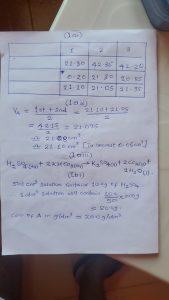
NUMBER ONE



NUMBER 2

(3ai)
To convert an aqueous solution of copper sulfate (CuSO₄) to an aqueous solution of zinc sulfate (ZnSO₄), you can use a displacement reaction involving zinc.
CuSO₄(aq) + Zn(s) —> ZnSO₄ (aq) + Cu(s)
In this reaction, zinc (Zn) displaces copper (Cu) from copper sulfate (CuSO₄) because zinc is more reactive than copper. The zinc sulfate (ZnSO₄) formed is soluble in water and remains in the solution.
(3aii)
CuSO₄(aq) + Zn(s) —> ZnSO₄ (aq) + Cu(s)
(3b)
(i) A titrant is a solution of known concentration that is used to determine the concentration of another solution through a chemical reaction. It is added to the solution being analyzed during a titration.
(ii) Concordant titres refer to the multiple titration results that are within a narrow range of values, indicating that they are consistent and reliable. When the titration results are concordant, it means they are close to each other, and their average can be taken as an accurate measurement.

Leave a Reply